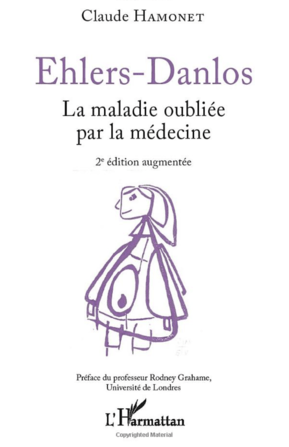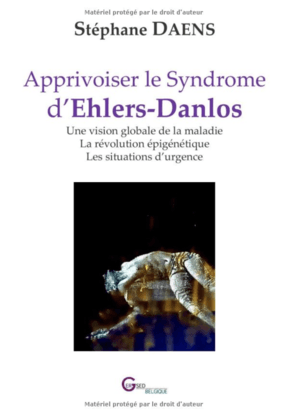Les livres sur les SED
_


Parutions scientifiques sur les SED & bibliographie
_
En cours de constitution, la base de données de publications sur les SED et HSD sur Zotero
- Tinkle B, Castori M, Berglund B, Cohen H, Grahame R, Kazkaz H, Levy H. 2017. Hypermobile Ehlers–Danlos syndrome (a.k.a. Ehlers–Danlos syndrome Type III and Ehlers–Danlos syndrome hypermobility type) : Clinical description and natural history. Am J Med Genet Part C Semin Med Genet 175C:48–69.
- Smith C. 2017. Understanding Hypermobile Ehlers-Danlos Syndrome and Hypermobility Spectrum Disorder. Redcliff-House Publications 2017.
- The Ehlers-Danlos Society. EDNF becomes The Ehlers-Danlos Society. Retrieved from https://www.ehlers-danlos.com/ednf-becomes-the-ehlers-danlos-society/
- Chopra P, Tinkle B, Hamonet C, Brock I, Gompel A, Bulbena A, Francomano C. 2017. Pain management in the Ehlers-Danlos syndromes. Am J Med Genet Part C Semin Med Genet 175C:212-219
- Tennant F. 2015. Managing Intractable Pain in Ehlers-Danlos. Retrieved from https://www.youtube.com/watch?v=pLw29ndmLcA
- Dupuy EG, Leconte P, Vlamynck E, Sultan A, Chesneau C, Denise P, Besnard S, Bienvenu B, Decker LM. 2017. Ehlers-Danlos Syndrome, Hypermobility Type : Impact of Somatosensory Orthoses on Postural Control (A Pilot Study). Front. Hum. Neurosci. 11:283. Doi : 10.3389/fnhum.2017.00283
- Hamonet C, Vlamynck E, Haidar R, Bonny C, Mazaltarine G. 2016. Le syndrome d’Ehlers-Danlos de type III. De la physiopathologie à la thérapeutique. J. réadapt. Méd. 36 :32-37.
- Pocinki A. 2014. Breaking the Cycle of Chronic Pain, Poor Sleep, Depression, and Fatigue. Retrieved from https://www.ehlers-danlos.com/2014-annual-conference-files/Alan%20Pocinki.pdf
- Hakim A, De Wandele I, O’Callaghan C, Pocinki A, Rowe P. 2017. Chronic fatigue in Ehlers-Danlos syndrome – hypermobile type. Am J Med Genet 175C :175-180
- Bravo JF. 2016. La dysautonomie dans le syndrome Ehlers-Danlos type III. J. réadapt.Méd. 36 :52-55
- Henderson Sr. FC, Austin C, Benzel E, Bolognese P, Ellenbogen R, Francomano CA, Ireton C, Klinge P, Koby M, Long D, Patel S, Singman EL, Voermans NC. 2017. Neurological and spinal manifestations of the Ehlers–Danlos syndromes. Am J Med Genet Part C Semin Med Genet 175C:195–211.
- Marié Tanay C. 2015. Etude des apports de la L-Dopa dans le traitement du syndrome d’Ehlers-Danlos
- Hamonet C, Brock I, Pommeret St, Pommeret S, Amoretto R, Baeza-Velasco C, Metlaine A. 2017. Syndrome d’Ehlers-Danlos (SED) type III (hypermobile) : validation d’une échelle clinique somatosensorielle (ECSS-62), à propos de 626 cas. Bull. Acad. Natle Méd., 2017, 201, n°2.
- Malfait F, Francomano C, Byers P, Belmont J, Berglund B, Black J, Bloom L, Bowen JM, Brady AF, Burrows NP, Castori M, Cohen H, Colombi M, Demirdas S, De Backer J, De Paepe A, Fournel-Gigleux S, Frank M, Ghali N, Giunta C, Grahame R, Hakim A, Jeunemaitre X, Johnson D, Juul-Kristensen B, Kapferer-Seebacher I, Kazkaz H, Kosho T, Lavallee ME, Levy H, Mendoza-Londono R, Pepin M, Pope FM, Reinstein E, Robert L, Rohrbach M, Sanders L, Sobey GJ, Van Damme T, Vandersteen A, van Mourik C, Voermans N, Wheeldon N, Zschocke J, Tinkle B. 2017. The 2017 international classification of the Ehlers-Danlos syndromes. Am J Med Genet Part C Semin Med Genet 175C:8-26.
- Francomano C, Bloom L. 2017. The 2017 EDS Classification Your Questions Answered. Retrieved from https://ehlers-danlos.com/wp-content/uploads/QandA-2.pdf
- Grahame R. 2016. Le syndrome d’hypermobilité. J.réadapt.Méd. 36 :7-8
- Hamonet C. 2011. Conseils pour une bonne utilisation du stimulateur électrique antidouleur TENS dans les syndromes d’Ehlers-Danlos (SED). Retrieved from https://www.ased.fr/files/TENS_UTILISATION.pdf
- Engelbert RH, Juul-Kristensen B, Pacey V, de Wandele I, Smeenk S, Woinarosky N, Sabo S, Scheper MC, Russek L, Simmonds JV. 2017. The evidence-based rationale for physical therapy treatment of children, adolescents, and adults diagnosed with joint hypermobility syndrome/hypermobile Ehlers Danlos syndrome. Am J Med Genet Part C Semin Med Genet 175C:158–167.
- Chopra P. 2017. Management of complex pain in children and adults with Ehlers Danlos Syndromes. Retrieved from https://www.ehlers-danlos.com/pdf/The-EDS-Society-Pain-presentation-Chopra-2017-S.pdf
- Parry J. 2017. Dislocation/Subluxation Management, or ‘I’m Just Popping out for a while. Retrieved from https://www.ehlers-danlos.com/dislocation-subluxation-management/
- Eds.info. Fatigue and EDS-H/JHS. Retrieved from https://www.edhs.info/about1-c1ah1
- Jamieson-Lega K, Berry R, Brown CA. 2013. A concept analysis of a chronic pain intervention. Pain Res Manag 2013; 18(4):207-2013
- De Coster P, Martens L, De Paepe A. 2005. Oral health in prevalent types of Ehlers-Danlos syndromes. Journal of Oral Pathology and Medicine,34,298–307.
- Arulanandam S, Tang J, Sandhu G, Birchall M. 2016. Laryngological presentations of Ehlers–Danlos syndrome: case series of nine patients from two London tertiary referral centres. Clinical otolaryngology,42, 860-863.
- Weir F, Hatch J, Muus J, Wallace S, Meyer T. 2016. Audiologic Outcomes in Ehlers-Danlos Syndrome in Otology and neurology, 748-752.
- Baeza-Velasco C., Bourdon C., Polance-Carrasco R., De jouvencel M., Gely-Nargeot M.C., Gompel A. (2017). Cognitive impairment in women with joint hypermobility syndrome/Ehlers-Danlos syndrome hypermobility type. Rheumatology international,37,937-939.
- Bourdon C, De Jouvencel M, Baeza-Velasco C, Hamonet, C. 2016.Trastornos cognitivos en el sindrome de Ehlers-Danlos. Cuadernos de Neuropsicologia, 10, 72-77.
- Metlaine A. 2016. Sommeil et fatigue chez les patients souffrant de syndrome d’Ehlers-Danlos. J.réadapt.Méd. 36 :62-63
- Hamonet C, Vienne M, Leroux C, Letinaud MP, Paumier J, Dehecq B, Metlaine A, Brock I, Bird FM. 2016. Manifestations respiratoires dans le syndrome d’Ehlers-Danlos (SED). Nouveaux apports thérapeutiques. J.réadapt.Méd. 36 :56-61.
- Grossin D, Daens S. 2018. Le Syndrome d’Ehlers-Danlos et le Syndrome d’Activation Mastocytaire : le SAMED ?
« Les informations fournies sur le site gersed.org sont destinées à améliorer et non à remplacer, la relation directe entre le patient (ou visiteur du site) et les professionnels de santé. »
Vous voulez nous soutenir ?
_

